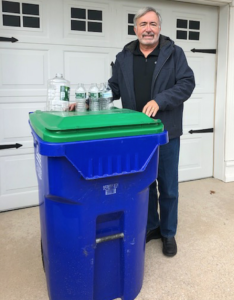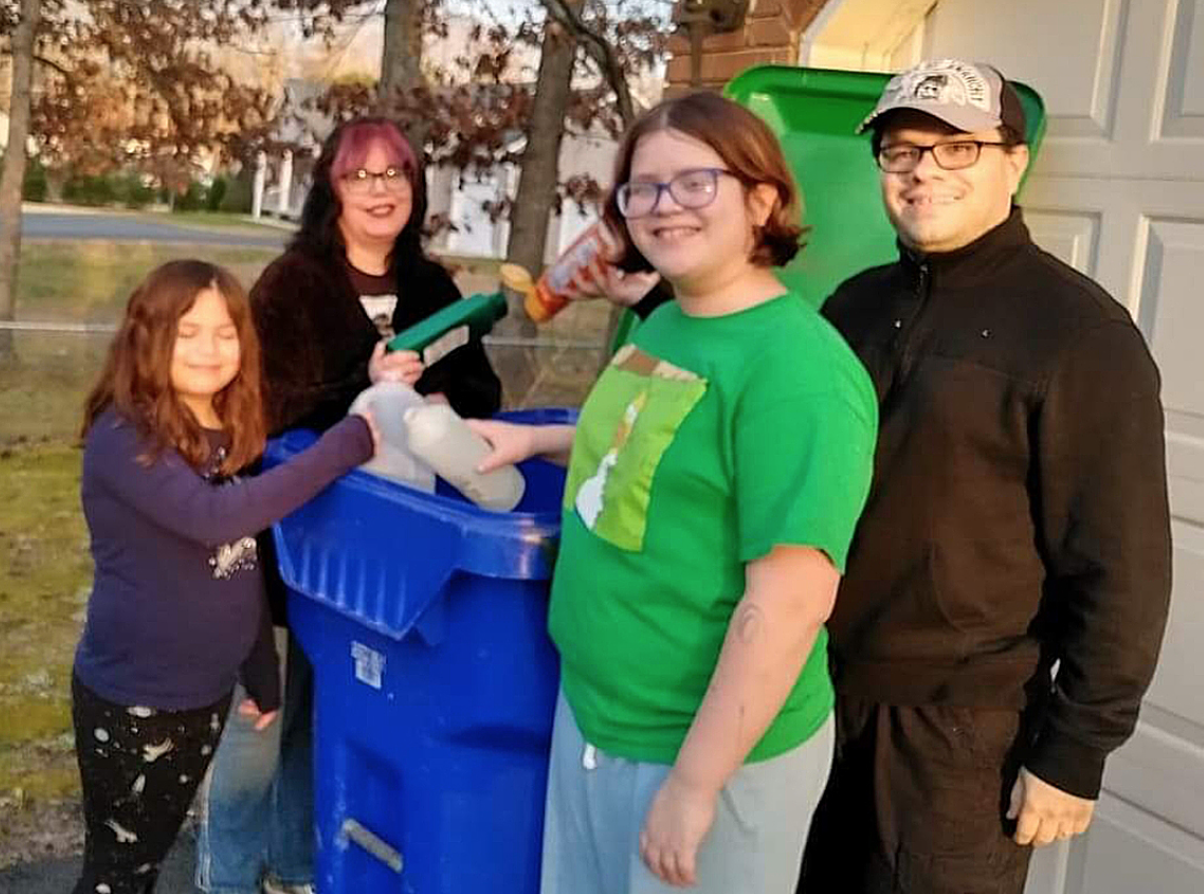
With the seeming omnipresence of plastic in virtually all aspects of life, it is often easy to overlook how much of the material is used and discarded on a daily basis. However, three families in Hammonton agreed to track their plastic usage to determine precisely how much they used, every day, for a week.
Bill Cappuccio, 69, and his wife, Lorraine, participated in the survey. At the end of the week, Cappuccio said that they had discarded 38 plastic bottles, 13 single-use plastic shopping bags, one plastic butter container, one plastic take-out container, one Ziploc bag and one plastic pill bottle.

Bill Cappuccio stands beside one days’ worth of plastic usage
Cappuccio said that this usage was “about what we expected.”
“We realize that a bulk of our plastic recycling is plastic water bottles. We do recycling for a lot of other items: paper, aluminum cans, cardboard, catalogs, etc. Our recycling bucket is usually filled every two weeks,” he said.
Jane Velazquez, 41, also took part in the survey, along with her husband, Donny, 45, and their two daughters, Raven, 12, and Luna, 8.
By week’s end, Velazquez said that her family had discarded four plastic bottles, 19 single-use plastic shopping bags, four yogurt cups, two to-go cups, one takeout soup container, two plastic dairy bottles, three plastic snack cups, two plastic piping bags and two plastic wrapping bags.

Luna, Jane, Raven and Donny Velazquez tracked their daily plastic usage for a week
“We’ve been trying to reduce, but I’m definitely working harder to now since I have a better idea of what we use. We already use metal straws, and since I’m currently unemployed I cook dinner more to reduce takeout waste … I usually forget to use my reusable shopping bags, but I’m making an effort to do so now,” Velazquez said.
Velazquez said that she has also been mindful when packing school lunches.
“I started using sandwich containers for school lunch instead of Ziploc bags … and I never send plastic cutlery to school in lunch boxes, I buy cheap silverware to send, so if they lose it it’s not my good stuff,” Velazquez said.
Mica McCullough, 33, and her husband, Eric Schmehl, were the third group of participants in the survey. By the end of their week, McCullough said that they had discarded one Styrofoam to-go container, two plastic cups, one plastic clip, one milk jug, one plastic vegetable tub, four plastic food bags, meat packaging, one to-go container, a blister package, plastic shipping packaging, a small clothing tag and the ring from a beer six-pack.
“It was slightly more than I expected, because we have worked so hard to reduce our single-use plastic over the past several years,” McCullough said.
McCullough, the past chair of the Hammonton Green Committee, noted ways to reduce plastic usage that she would like to implement.
“If it wasn’t winter and the produce markets were open, I prefer to buy my veggies there, which don’t come in a plastic bag. If we weren’t always pressed for time, I’d love to shop at local butchers more, which at least wrap to-order items in paper rather than foam and cling wrap,” McCullough said.
Amy Menzel, the current chair of the Hammonton Green Committee, said that it is a good idea for everyone to try to track their plastic usage.
“Awareness is key. There are so many things that we do without thinking. It’s important to be aware of what we are buying and consuming, how we use it and what happens to all the stuff we buy,” Menzel said.
Menzel said that plastic is convenient to both use and make.
“It’s relatively inexpensive to produce, and can be formed into just about any shape or size to create different products. When you stop to consider how much plastic we use, it might be tempting to just throw your hands up or to be overwhelmed. There are, however, lots of simple steps you can take to reduce the amount of plastic you use and discard. You don’t have to give it up 100 percent; just look for some things that will be easy to adopt to start,” Menzel said.
Menzel said that the best reminders include the “3 R’s”: reduce, reuse and recycle.
“Reduce is the first ‘R’ because the best thing you can do is to use less stuff—and less plastic in particular. Reusing is great, too; can you use what you have again? Get creative. Recycling is important on many levels; it keeps waste out of landfills and recycled material is turned into new products which saves natural resources,” Menzel said.
Recycling, Menzel said, is easy, convenient and makes a difference.
“Make sure you are recycling right; [but] as great as recycling is, we can’t recycle our way to a perfect, waste free world. Reducing and reusing are really important,” Menzel said.
Chief among reusing, Menzel said, is through reusable shopping bags—which will be particularly important after May 4, 2022, when New Jersey’s single-use plastic bag ban takes effect.
“Get in the habit. Keep bags in your trunk. Restock your supply after you bring bags in from the car. Use, restock, repeat and, before you know it, it’s a habit, and you’ll rarely find yourself without your bags. Remember, the grocery store is not the only place you may need a bag. Bring your bag to the pharmacy, the hardware store and your favorite shop downtown. Get a couple bags that fold up small and are easy to carry and stash in your purse or even in a coat pocket,” Menzel said.
Noting the prevalence of plastic bottles and cups among the daily usage, Menzel offered some tips on how to reduce the use of those items.
“Cut out bottled water. We’ve got good water coming right out of the faucet. Get some reusable water bottles that you really like; something that is easy to clean and to drink from and that doesn’t leak. Make sure they are easy to access, so you can grab it and go. This is an excellent way to save money and reduce waste, too. Think about other reusables too. A steel travel cup can keep your morning coffee hot without creating waste, and it’s now common practice to bring your own travel mug to fill up where you get your coffee. Reusable straws are made from a variety of materials and come in many different styles,” Menzel said.
Menzel recommended reusing several items during the course of the day, particularly regarding food outside of the home.
“Another thing I keep in my car along with bags are a few small containers I can grab for leftovers if I am eating out. Nothing fancy, just a few repurposed plastic containers—reuse!—with lids that fit. It’s so much better than coming home with a giant Styrofoam container that will spend hundreds of years sitting in the landfill after its few minutes of use. For lunches, bring your own utensils and you won’t need to grab a plastic fork or spoon. There are special travel utensils made from bamboo or other natural materials, but why not bring your own knife and fork from home? It’s not necessary to buy something you already have,” Menzel said.
Menzel also suggested using less plastic in the kitchen.
“Glass containers are a nice alternative to plastic for food storage, especially for reheating leftovers,” Menzel said.
When shopping, Menzel said, customers can look for natural alternatives to substitute for plastic items.
“For example, look for cotton balls instead of the synthetic version; bonus points for organic cotton that’s grown without chemical fertilizers or pesticides. Natural products are a great choice for skin care products or clothing. There are natural/plant-based alternatives to many plastic household items—sponges made from biodegradable cellulose, plant pots made from bamboo and other natural materials,” Menzel said.
Everything we use, Menzel said, comes from nature, even plastic.
“Plastic comes from petroleum, a non-renewable resource. So recycling plastic saves oil,” Menzel said.
Menzel said that how a product is packaged is another thing to consider.
“There are companies that sell products which have less packaging or packaging that is easy to recycle,” Menzel said.
Menzel said that there are several stores in the area, like The Refill Market in Haddon Twp. and Fermented Food & Beverage Supply in Hammonton, that sell plastic-alternative items and allow customers to buy in bulk with their own containers to avoid unnecessary packages.
Reducing plastic waste, Menzel said, is not an insurmountable challenge.
“You don’t need to spend a ton of money or sacrifice your comfort or convenience. There are so many small and simple steps we can take that add up,” Menzel said.
This story was produced in collaboration with CivicStory (www.civicstory.org) and the NJ Sustainability Reporting project (www.SRHub.org).
